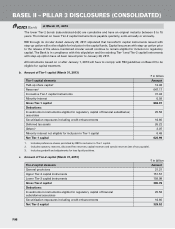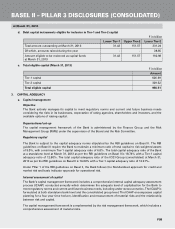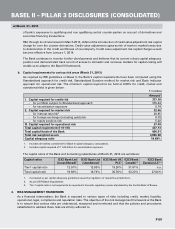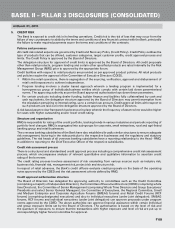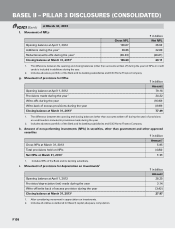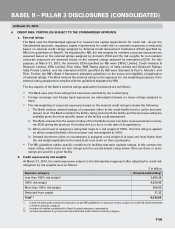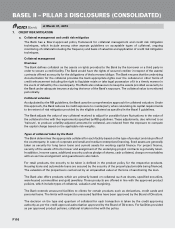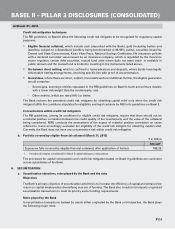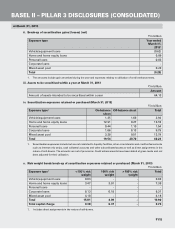ICICI Bank 2013 Annual Report Download - page 183
Download and view the complete annual report
Please find page 183 of the 2013 ICICI Bank annual report below. You can navigate through the pages in the report by either clicking on the pages listed below, or by using the keyword search tool below to find specific information within the annual report.
F105
c. credits in the account are not enough to cover the interest debited during the accounting period; or
d. drawings have been permitted in the account for a continuous period of 90 days based on drawing power
computed on the basis of stock statements that are more than three months old even though the unit may
be working or the borrower’s financial position is satisfactory; or
e. the regular/ad hoc credit limits have not been reviewed/renewed within 180 days from the due date/date
of ad hoc sanction.
iv) a bill purchased/discounted by the Bank remains overdue for a period of more than 90 days;
v) interest and/or installment of principal in respect of an agricultural loan remains overdue for two crop seasons
for short duration crops and one crop season for long duration crops;
vi) In respect of a securitisation transaction undertaken in terms of the RBI guidelines on securitisation, the
amount of liquidity facility remains outstanding for more than 90 days;
vii) In respect of derivative transactions, if the overdue receivables representing positive mark-to-market value of
a derivative contract, remain unpaid for a period of 90 days from the specified due date for payment.
Irrespective of payment performance, the Bank identifies a borrower account as a NPA even if it does not meet
any of the above mentioned criteria, where:
• loans availed by a borrower are repeatedly restructured unless otherwise permitted by regulations;
• loans availed by a borrower are classified as fraud;
• project does not commence commercial operations within the timelines permitted under the RBI guidelines
in respect of the loans extended to a borrower for the purpose of implementing a project; and
• any security in nature of debenture/bonds/equity shares issued by a borrower and held by the Bank is
classified as non-performing investment.
Further, NPAs are classified into sub-standard, doubtful and loss assets based on the criteria stipulated by RBI. A
sub-standard asset is one, which has remained a NPA for a period less than or equal to 12 months. An asset is
classified as doubtful if it has remained in the sub-standard category for more than 12 months. A loss asset is one
where loss has been identified by the Bank or internal or external auditors or during RBI inspection but the amount
has not been written off fully.
Restructured assets
As per RBI guidelines, a fully secured standard loan can be restructured by rescheduling principal repayments
and/or the interest element, but must be separately disclosed as a restructured loan in the year of restructuring.
Similar guidelines apply to restructuring of sub-standard and doubtful loans.
A restructured loan will be upgraded to the standard category only after the borrower demonstrates satisfactory
payment performance over a period of time and after the loan reverts to the normal level of standard asset
provisions and risk weights. RBI has specified the period to be one year from the date when the instalment/
interest falls due as per the restructuring scheme.
a. Credit risk exposures (March 31, 2013)
Credit risk exposures (excluding specific risk on available-for-sale and held-for-trading portfolio) include all
credit exposures as per RBI guidelines on exposure norms and investments in the held-to-maturity category.
Exposures to regulatory capital instruments of subsidiaries that are deducted from the capital funds have
been excluded.
` in billion
Category Credit exposure
Fund-based facilities15,871.08
Non-fund based facilities 2,799.49
Total2 8,670.57
1. Includes investment in government securities held under held-to-maturity category.
2. Includes all entities considered for Basel II capital adequacy computation.
BASEL II – PILLAR 3 DISCLOSURES (CONSOLIDATED)
at March 31, 2013





